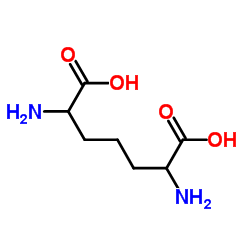2,6-二氨基庚二酸

2,6-二氨基庚二酸结构式

|
常用名 | 2,6-二氨基庚二酸 | 英文名 | DL-2,6-Diaminopimelic acid |
|---|---|---|---|---|
| CAS号 | 583-93-7 | 分子量 | 190.197 | |
| 密度 | 1.3±0.1 g/cm3 | 沸点 | 426.7±45.0 °C at 760 mmHg | |
| 分子式 | C7H14N2O4 | 熔点 | ~295 °C (dec.)(lit.) | |
| MSDS | 中文版 美版 | 闪点 | 211.8±28.7 °C | |
| 符号 |

GHS07 |
信号词 | Warning |
|
Bacillus lonarensis sp. nov., an alkalitolerant bacterium isolated from a soda lake.
Arch. Microbiol. 197(1) , 27-34, (2015) A novel Gram-stain-positive, rod-shaped, motile and endospore-forming novel bacterial strain 25nlg(T) was isolated from Lonar soda lake, in India. Based on the 16S rRNA gene sequence analysis, it was identified as a member of Firmicutes, being most closely re... |
|
|
Salegentibacter chungangensis sp. nov., isolated from a sea sand and emended description of the genus Salegentibacter.
Int. J. Syst. Evol. Microbiol. 64(Pt 5) , 1514-9, (2014) A Gram-stain-negative, non-motile, rod-shaped, strictly aerobic bacterial strain, designated CAU 1289T, was isolated from a marine sand and its taxonomic position was investigated using a polyphasic approach. It grew optimally at pH 6.5 and 30 °C and in the p... |
|
|
Bacillus luteus sp. nov., isolated from soil.
Int. J. Syst. Evol. Microbiol. 64(Pt 5) , 1580-6, (2014) Two bacterial strains (JC167T and JC168) were isolated from a soil sample collected from Mandpam, Tamilnadu, India. Colonies of both strains were orange and cells Gram-stain-positive. Cells were small rods, and formed terminal endospores of ellipsoidal to ova... |
|
|
Micromonospora kangleipakensis sp. nov., isolated from a sample of limestone quarry.
Int. J. Syst. Evol. Microbiol. 63(Pt 12) , 4546-51, (2013) Strain MBRL 34(T), isolated from a sample of limestone quarry located at Hundung, Manipur, India, was characterized by polyphasic taxonomy. The strain showed the highest 16S rRNA gene sequence similarity with Micromonospora echinaurantica DSM 43904(T) (98.4 %... |
|
|
Sensing of commensal organisms by the intracellular sensor NOD1 mediates experimental pancreatitis.
Immunity 37(2) , 326-38, (2012) The intracellular sensor NOD1 has important host-defense functions relating to a variety of pathogens. Here, we showed that this molecule also participates in the induction of a noninfectious pancreatitis via its response to commensal organisms. Pancreatitis ... |
|
|
Saccharothrix saharensis sp. nov., an actinomycete isolated from Algerian Saharan soil.
Int. J. Syst. Evol. Microbiol. 63(Pt 10) , 3744-9, (2013) The taxonomic position of a novel actinomycete, strain SA152(T), isolated from a sample of Algerian Saharan soil, was determined using a polyphasic taxonomic approach. The strain produced abundant aerial mycelium and fragmented substrate mycelium on most medi... |
|
|
The metabolic fate of 14C-labeled immunoadjuvant peptidoglycan monomer. II. In vitro studies.
Biochim. Biophys. Acta 678(1) , 12-7, (1981) Peptidoglycan monomer (GlcNAc-MurNAc-L-Ala-D-isoglutamine-meso-diaminopimelic acid-D-Ala-D-Ala), labeled with 14C both in the disaccharide and pentapeptide portions, was incubated with slices of mouse liver, kidney or spleen as well as with mouse and human bl... |
|
|
Expansion of the tetracycline-dependent regulation toolbox for Helicobacter pylori.
Appl. Environ. Microbiol. 81 , 7969-80, (2015) In an effort to gain greater understanding of the biology and infection processes of Helicobacter pylori, we have expanded the functionality of the tetracycline-dependent gene regulation (tet) system to provide more improved and versatile genetic control and ... |
|
|
Paenibacillus relictisesami sp. nov., isolated from sesame oil cake.
Int. J. Syst. Evol. Microbiol. 64(Pt 5) , 1534-9, (2014) A facultatively anaerobic, Gram-stain-positive, rod-shaped bacterium, designated strain KB0549T, was isolated from sesame oil cake. Cells were motile, round-ended rods, and produced central or terminal spores. The cell wall peptidoglycan contained meso-diamin... |
|
|
Distinguishing the cyanobacterial neurotoxin β-N-methylamino-L-alanine (BMAA) from other diamino acids.
Toxicon 57 , 730-738, (2011) β-N-methylamino-L-alanine (BMAA) is produced by diverse taxa of cyanobacteria, and has been detected by many investigators who have searched for it in cyanobacterial blooms, cultures and collections. Although BMAA is distinguishable from proteinogenic amino a... |